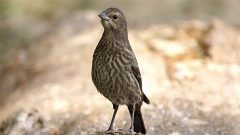Brown-headed Cowbird Photo Gallery
Adult male
Chunky blackbird with a thick, conical bill. Adult males have black bodies and brown heads, which can appear all black in poor light.
© Jack & Holly Bartholmai / Macaulay LibraryWisconsin, May 09, 2010Female
Stocky blackbird with a short tail and a thick, conical bill. Female Brown-headed Cowbirds are plain brown, lightest on the head and underparts, with fine streaking on the belly and a dark eye.
© Jonathan Irons / Macaulay LibraryMaryland, February 20, 2019Adult male
Often ruffles neck feathers when singing. Song includes thin, high notes and a liquid burbling sound (other calls in background are Red-winged Blackbirds.) Note thick, sharply pointed bill.
© Timothy Barksdale / Macaulay LibraryTexas, April 01, 1998Not all videos have soundJuvenile
Juveniles are brown overall with a scaly-looking back and streaked underparts.
© Sean Fitzgerald / Macaulay LibraryMinnesota, July 10, 2018Immature male
Immature males molting into adult plumage are patchy brown and black.
© Linda Lewis / Macaulay LibraryMaryland, August 24, 2016Female
Females are plain brown with very little streaking. The short, thick-based, sharply pointed bill is a key mark.
© Timothy Barksdale / Macaulay LibraryArkansas, April 14, 2004Not all videos have soundJuvenile (with Chipping Sparrow)
Lays eggs in the nest of other birds, which raise cowbird young. Here a Chipping Sparrow feeds a juvenile cowbird as if it were her own.
© Christophe Buidin / Macaulay LibraryNew Jersey, May 31, 2017Adult male
Adult male has a brown head, glossy black upperparts, a short tail, and a heavy bill.
© Ryan Sanderson / Macaulay LibraryIndiana, April 11, 2020Adult males and females
Highly social: forages and displays on the ground in open areas. Displaying males puff out feathers, point bill at the sky, and bow forward and raise tail.
© Timothy Barksdale / Macaulay LibraryArkansas, April 01, 2004Not all videos have soundAdult male
Typically forages on the ground, often in mixed flocks of blackbirds, grackles, and starlings. Males also gather on lawns to strut and display for mates.
© Andrew Simon / Macaulay LibraryMichigan, May 01, 2020Female
Female does not build a nest, instead laying her eggs in the nest of other species.
© Emily Turteltaub Nelson / Macaulay LibraryNew Jersey, May 27, 2017Adult males
Originally lived around herds of bison, foraging on insects stirred up as the animals grazed. Now often seen on and around cows and other livestock.
© Timothy Barksdale / Macaulay LibraryMontana, June 01, 2000Not all videos have soundAdult male
Highly gregarious. Males often raise their back and chest feathers, lift their wings, spread their tail feathers, and bow forward when singing.
© Ann Tanner / Macaulay LibraryMissouri, May 18, 2017Adult male and female
Found in open habitats such as fields, pastures, meadows, forest edges, and lawns. When not displaying or feeding on the ground, they often perch high on prominent tree branches.
© Nick Pulcinella / Macaulay LibraryPennsylvania, March 14, 2015Habitat
Originally associated with bison on the Great Plains, but now found around horses and cattle.
© Amiel Hopkins / Macaulay LibraryVirginia, September 28, 2019Compare with Similar Species
Click on an image to compare
Species in This Family
Troupials and Allies(Order: Passeriformes, Family: Icteridae)
More to Read
Don't miss a thing! Join our email list
The Cornell Lab will send you updates about birds,
birding, and opportunities to help bird conservation.






























